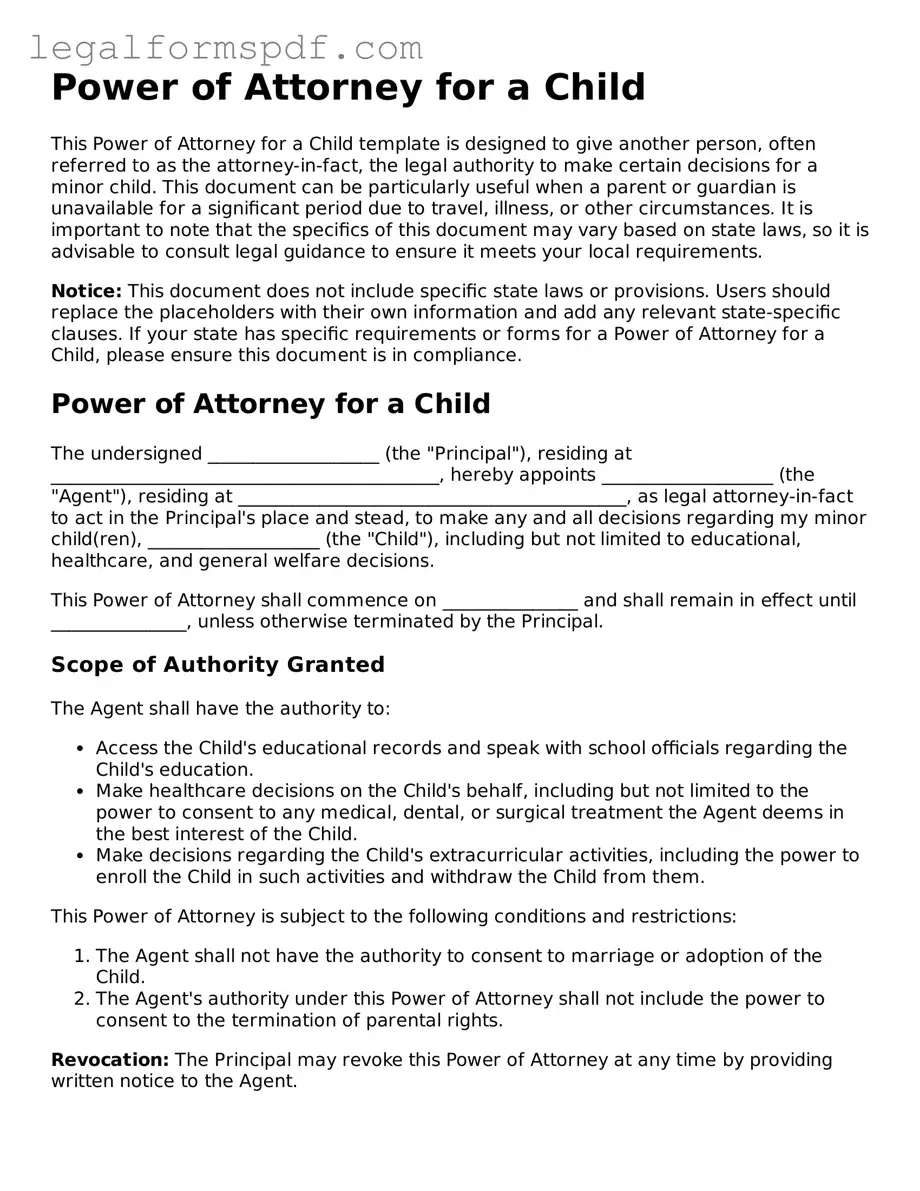Power of Attorney for a Child
This Power of Attorney for a Child template is designed to give another person, often referred to as the attorney-in-fact, the legal authority to make certain decisions for a minor child. This document can be particularly useful when a parent or guardian is unavailable for a significant period due to travel, illness, or other circumstances. It is important to note that the specifics of this document may vary based on state laws, so it is advisable to consult legal guidance to ensure it meets your local requirements.
Notice: This document does not include specific state laws or provisions. Users should replace the placeholders with their own information and add any relevant state-specific clauses. If your state has specific requirements or forms for a Power of Attorney for a Child, please ensure this document is in compliance.
Power of Attorney for a Child
The undersigned ___________________ (the "Principal"), residing at ___________________________________________, hereby appoints ___________________ (the "Agent"), residing at ___________________________________________, as legal attorney-in-fact to act in the Principal's place and stead, to make any and all decisions regarding my minor child(ren), ___________________ (the "Child"), including but not limited to educational, healthcare, and general welfare decisions.
This Power of Attorney shall commence on _______________ and shall remain in effect until _______________, unless otherwise terminated by the Principal.
Scope of Authority Granted
The Agent shall have the authority to:
- Access the Child's educational records and speak with school officials regarding the Child's education.
- Make healthcare decisions on the Child's behalf, including but not limited to the power to consent to any medical, dental, or surgical treatment the Agent deems in the best interest of the Child.
- Make decisions regarding the Child's extracurricular activities, including the power to enroll the Child in such activities and withdraw the Child from them.
This Power of Attorney is subject to the following conditions and restrictions:
- The Agent shall not have the authority to consent to marriage or adoption of the Child.
- The Agent's authority under this Power of Attorney shall not include the power to consent to the termination of parental rights.
Revocation: The Principal may revoke this Power of Attorney at any time by providing written notice to the Agent.
Governing Law: This Power of Attorney for a Child shall be governed by the laws of the state in which the Principal resides. If any provision of this document is found to be invalid or unenforceable, the remaining provisions shall remain effective.
IN WITNESS WHEREOF, the Principal has executed this Power of Attorney on this __________ day of __________, 20__.
_____________________________________
Signature of Principal
_____________________________________
Signature of Agent
State of ________________________
County of ______________________
On this __________ day of __________, 20__, before me, the undersigned officer, personally appeared ___________________, known to me (or satisfactorily proven) to be the person whose name is subscribed to the within instrument, and acknowledged that they executed the same for the purposes therein contained.
In witness whereof, I hereunto set my hand and official seal.
_____________________________________
Notary Public
My Commission Expires: _______________
